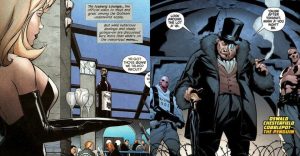15 Best TV Period Dramas Set In The 1920s (According To IMDb)

The 1920s, also known as the Roaring Twenties or the Jazz Age, were a period of great social and political change. Women won the right to vote and entered the workforce in greater numbers. Prohibition in the United States created a black market for alcohol that was a boon to organized crime. In Britain, deference toward the aristocracy began to crumble, blurring the lines between class distinctions.
It was a time of unprecedented change with a distinct cultural edge – the era is also known for Art Deco and the iconic flapper. The excitement and rebellion of this era continue to be prominent features in popular culture. The 20s are frequently the inspiration or setting for period dramas, exploring stories about flappers and bootleggers, fading aristocrats, and empowered workers.
Updated on March 21st, 2021 by Svetlana Sterlin: Just when it seems that every aspect of a certain era has been explored on screen, a new period drama is released that offers a fresh perspective from a different point of view. Streaming is now officially king, and the major platforms seem to be rolling out new productions without pause. Period dramas are particularly popular, especially when the world seems like it’s buried a little too deep in social upheaval when all consumers want to do is escape to another time. The 1920s seem particularly glamorous and attractive, but the truth is that they’re just as tumultuous as the 2020s, reflecting injustices that are still present in the world today.
15 Cable Girls (Las Chicas Del Cable) – 7.6

This Spanish period drama takes place in the late 1920s. Set in Madrid, it focuses on four friends from different walks of life. The one thing they all have in common is that they’re all telephone operators, a job that gives them independence and decent pay, bringing about many life changes.
Cable Girls is acclaimed for depicting the hardships that Spanish women face in a male-dominated society. The electropop soundtrack is packed with hits from the 2010s is a striking contrast to the 20s sets and clothing.
14 Mr. Selfridge – 7.7

The central character in Mr. Selfridge is none other than Harold Gordon Selfridge, the British-American retail magnate and founder of the eponymous department store. The show begins with the store’s founding in 1908 and follows the trials and triumphs of the Selfridge family and their staff through 1929.
While Selfridge’s early history is true to life, the workers at the store are fictional. Nonetheless, viewers may appreciate the realistic accounts of life behind the store counter, as well as Jeremy Pivens’ subtle performance in the title role.
13 The Thorn Birds – 7.9

Based on Colleen McCullough’s novel of the same name, this 1983 miniseries is set in the Australian outback of the early 20th century. Father Ralph is a priest who is forced to decide between his ambitions and his feelings for Meggie Cleary.
When the wealthy Cleary family moves to a sheep station, Meggie and Ralph are instantly drawn to each other. Their attraction becomes obvious to the local community, so Meggie’s aunt puts the decision before him: a life with Meggie or a life in the church.
12 Lilies – 8.0

This BBC series takes place in 1920s Liverpool and is about three sisters in their early 20s who live near the docks with their father and brother. The British miniseries focuses on the change these young women face as they transition from girlhood to adulthood.
The Catholic family of Iris, May, Ruby, and their widowed father feels the aftereffects of World War One. The lively sisters are about to experience many things for the first time, and their terraced house on the docks is a setting just as tumultuous as this period of their lives.
11 The House of Eliott – 8.0

After the sudden death of their father, sisters Evangeline and Beatrice have no prospects and no hope for a future in society. That is, until they put their talents in dressmaking to use and become the most celebrated fashion designers in London.
New opportunities for women are at the forefront of this series, which aired from 1991 to 1994. Audiences loved the entrepreneurial main characters and their gorgeous costumes, as well as the cutthroat world of fashion.
10 The Roaring 20s – 8.1

As the title suggests, this series is all about the rowdiness of this iconic decade. Starring Rex Reason, Donald May and Dorothy Provine, the show ran for two seasons on the ABC between 1960 and 1962.
Scott Norris, Pat Garrison, and Duke Williams are newspaper reporters for the fictitious New York Record. They, along with copy-boy Chris Higby, report on crime and gangsters, while other characters, like a police lieutenant and a club singer, add flavor to the vibrant setting.
9 The Bretts – 8.3

The Bretts are a family of actors who deal with the everyday struggles of theatre life in 1920s Britain. The PBS program aired from 1987 to 1989, for two seasons.
At the heart of the story are Lydia and Charles Brett, both actors, both dealing with their own set of struggles. The series begins when Lydia accepts a role in a play that doesn’t hold much opportunity for Charles.
8 Miss Fisher’s Murder Mysteries – 8.3

Phryne Fisher is a woman of many talents. She can fly a plane, drive a car, speak a million languages, and even wear trousers on occasion. She is also a formidable private detective who solves all manner of crimes in 1920s Melbourne, with the help of her maid Dot and detectives Jack Robinson and Hugh Collins.
Phryne might appear frivolous, but her priority has always been to bring justice for those who can’t help themselves. The show has been described as great fun, with a strong, independent, and inspiring female lead whose wardrobe many fashionistas will covet.
7 Upstairs Downstairs – 8.3

The original Upstairs Downstairs that aired in the 1970s follows the Bellamy family and their servants at 165 Eaton Place. Although the house is run by a member of Parliament and his socialite wife, the show gives the downstairs characters their due with rich storylines and characterizations.
The fifth and final season is set between 1919 and 1930 and works real-life events into the story such as the post-war recovery and the 1926 general strike.
6 Babylon Berlin – 8.4

This neo-noir drama hails from Germany and is set during the Weimar Republic, beginning in April 1929. It highlights the widespread poverty and hunger after Germany lost World War I, and the forces that led to the formation of the Nazis and other far-right groups.
The show also dives into the rarely explored cultural Renaissance in Berlin, depicted via opulent nightlife scenes. The quality of the writing and acting led some viewers to wonder if the BBC had finally met its match in the creation of period dramas.
5 Brideshead Revisited – 8.5

The 1981 television adaptation of Evelyn Waugh’s novel explores the declining influence of the aristocracy in Britain. It remains one of the finest examples of British period drama for its lush production values and faithfulness to the source material.
Brideshead Revisited is also acclaimed for its compelling performances. Jeremy Irons brings the protagonist Charles Ryder to life on screen, while Anthony Andrews and Julia Quick are remarkable as Sebastian and Julia Flyte of the doomed and very Catholic Marchmain family.
4 Boardwalk Empire – 8.5

Across the pond, the 18th Amendment made the production and sale of alcohol illegal in the United States. Prohibition is the setting of Boardwalk Empire, a crime drama set in Atlantic City.
Steve Buscemi stars as Enoch “Nucky” Thompson, a local politician who leads a double life as a gangster. He becomes increasingly ruthless in order to compete in the violent bootlegging business but shows a softer side to his family and constituents who are unaware of his corruption. Viewers appreciate Nucky’s complexity and praise the strong writing of the female characters.
3 Downton Abbey – 8.7

The show that started the period drama boom, Downton Abbey, is another upstairs-downstairs story, this time featuring the Grantham family in Yorkshire. The show opens with a succession crisis, brought about by the sinking of the Titanic that killed both heirs in 1912.
It follows Lord Grantham, eldest daughter Lady Mary, and their staff through World War One and the beginning of the Roaring 20s. The show is much loved for its intricate costumes, relatable characters, and Dame Maggie Smith’s performance as the family matriarch Violet Crawley.
2 You Rang, M’Lord? – 8.7

A forgotten classic, You Rang, M’Lord? is a BBC drama following the adventures of Lord Meldrum, his family, and his servants, who live on an estate. The series is first and foremost a comedy, as per the title.
The British sitcom makes fun of the intensely private wealthy family at the heart of the story, but it’s one that audiences fell in love with when it aired from 1988 to 1993. Still, even this lighthearted series can’t ignore the war, even if it takes a slightly different approach to showing its impact.
1 Peaky Blinders – 8.8

The highest-rated period drama on IMDb is Peaky Blinders, and it couldn’t be more different from the runner-up. The part-fiction part-history show stars Cillian Murphy as Thomas Shelby, leader of the Peaky Blinders, a gang that ruled Birmingham at the end of World War I.
Shelby is cunning and ambitious, with plans to expand his organization beyond its current stronghold. Peaky Blinders is told from the gang’s point of view, making Chief Inspector Campbell (played by Sam Neill) the primary antagonist. The show also features numerous empowered female characters, as well as characters of diverse backgrounds.
About The Author
















